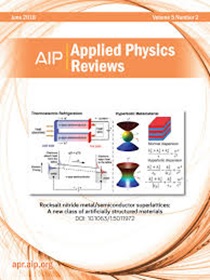同构有机晶体族:具有很大不同物理和太赫兹性质的类似晶体结构
IF 11.6
1区 物理与天体物理
Q1 PHYSICS, APPLIED
引用次数: 0
摘要
有机太赫兹(THz)晶体在化学结构、晶体结构和物理性质之间表现出复杂且往往不可预测的关系。这种复杂性使得优化晶体以有效产生太赫兹变得非常具有挑战性。在这里,我们介绍了一种基于同构离子有机晶体族的设计策略,以开发新的有机非线性光学晶体,有效地产生延伸到15太赫兹的超宽带太赫兹波。利用三种具有不同离子间组装类型的非线性光学阳离子发色团,分别与三个具有不同取代基(非极性甲基或极性氯和溴基)的分子阴离子结合,我们研究了9个离子晶体,其中4个为首次报道。每个同构晶体族中的晶体成员具有几乎相同的晶体结构(即同构晶体结构),它们都实现了顶级宏观二阶光学非线性和高效的超远太赫兹波产生能力。值得注意的是,它们在每个同构晶体家族中的物理(和太赫兹)性质根据引入阴离子的特定顺序而显着不同,并且这种顺序趋势在所有三个同构晶体家族中都持续存在。这些结果为离子有机太赫兹晶体和非线性光学晶体的宏观性质的设计和预测提供了重要的进展,标志着向具有增强物理性质的理性晶体设计迈出了重要的一步。本文章由计算机程序翻译,如有差异,请以英文原文为准。
Isomorphic organic crystal families: Analogous crystal structure with largely different physical and terahertz properties
Organic terahertz (THz) crystals exhibit complex and often unpredictable relationships among their chemical structures, crystal structures, and physical properties. This complexity makes it highly challenging to optimize crystals for efficient THz generation. Here, we introduce a design strategy based on isomorphic ionic organic crystal families to develop new organic nonlinear optical crystals that efficiently generate ultra-broadband THz waves extending up to 15 THz. Using three nonlinear optical cationic chromophores with different interionic assembly types, each combined with three molecular anions featuring different substituents (non-polar methyl or polar chloro and bromo groups), we investigated nine ionic crystals, including four reported here for the first time. The crystal members within each isomorphic crystal family show nearly identical crystal structures (i.e., isomorphic crystal structures), all of them achieving top-level macroscopic second-order optical nonlinearity and efficient ultrabroad THz wave generation capabilities. Remarkably, their physical (and terahertz) properties within each isomorphic crystal family differ dramatically according to a certain order of the introduced anions, and this ordering trend persists across all three isomorphic crystal families. These results provide a crucial advancement in the design and prediction of macroscopic properties in ionic organic THz and nonlinear optical crystals, marking an important step toward rational crystal design exhibiting enhanced physical properties.
求助全文
通过发布文献求助,成功后即可免费获取论文全文。
去求助
来源期刊

Applied physics reviews
PHYSICS, APPLIED-
CiteScore
22.50
自引率
2.00%
发文量
113
审稿时长
2 months
期刊介绍:
Applied Physics Reviews (APR) is a journal featuring articles on critical topics in experimental or theoretical research in applied physics and applications of physics to other scientific and engineering branches. The publication includes two main types of articles:
Original Research: These articles report on high-quality, novel research studies that are of significant interest to the applied physics community.
Reviews: Review articles in APR can either be authoritative and comprehensive assessments of established areas of applied physics or short, timely reviews of recent advances in established fields or emerging areas of applied physics.
 求助内容:
求助内容: 应助结果提醒方式:
应助结果提醒方式:


